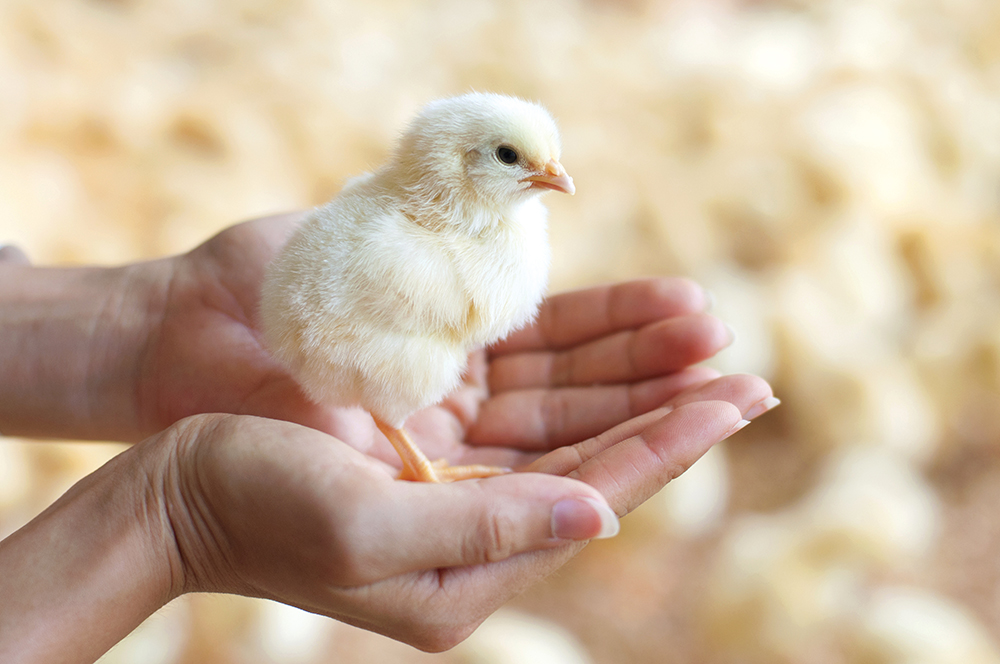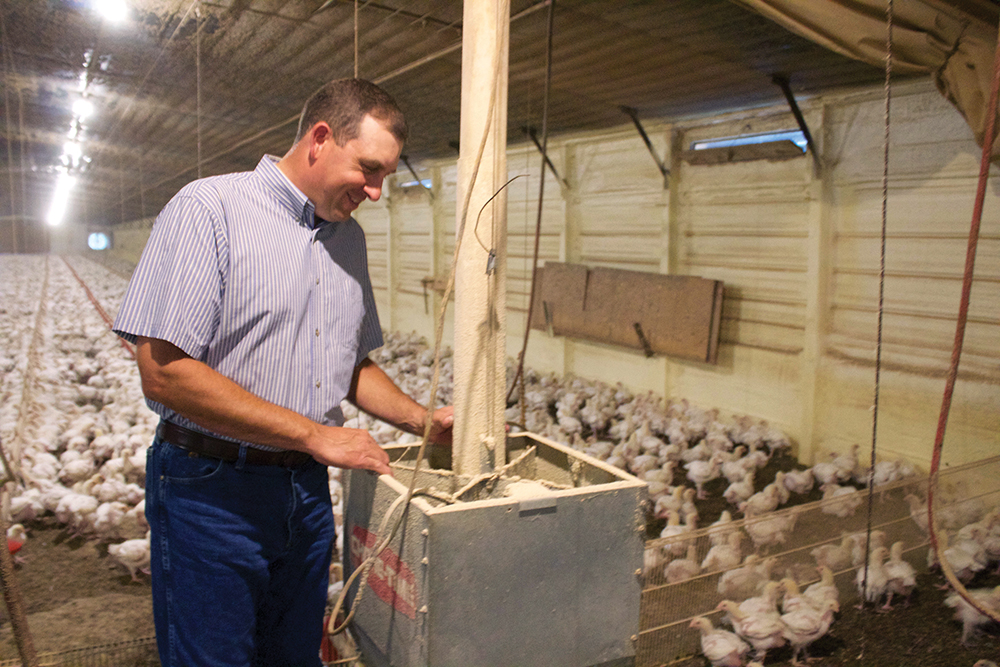
Photo courtesy Alabama Farmers Federation
By Ellie Isbell
Whether grilled or fried, wings or strips, there’s no doubt that Alabamians cherish America’s most popular entrée — chicken.
Meeting that demand is no small feat, and thousands of Alabama farm families raise poultry. Some farmers grow pullets, or young hens, to produce eggs for broiler, or meat-type, operations. There are also a small number of table egg producers in the state who produce eggs for grocery stores and restaurants. However, most Alabama farm families grow broilers, pushing the state to its number 2 ranking in U.S. broiler production.
One of these families, Chris and Monica Carroll of Ozark, has been raising broilers for 17 years. While Chris is a sixth-generation cattle farmer, poultry was a new endeavor for his family, who are members of Pea River Electric Cooperative.
“We built four broiler houses when our daughter Brittany was born in 2000,” Chris says. “I wanted Monica to come home to the farm and spend time with our kids.”
Monica was no stranger to agriculture. Her interest began when her sister brought home an animal science book in college.
“The more I learned about agriculture the more I became interested,” she says. “I asked myself why wouldn’t I want to be involved in ag? It’s an industry that affects us every single day. That moment marked a new beginning for me.”
Monica graduated with a bachelor’s degree in agricultural science from Auburn University in 1996. At Auburn, she met and married Chris, a ’95 animal science graduate. While Chris was on the farm, Monica worked for the USDA Natural Resource Conservation Service.
“One day Chris started giving me hay-raking lessons, and next thing I knew he was asking me to come home and farm,” Monica says. “He joked that I was a harder worker than anyone he ever hired!”
The addition of poultry houses proved successful for the Carrolls’ farm.

Photo courtesy Alabama Farmers Federation
A $15.1 billion impact on the economy
“Diversification in agriculture is important,” Chris says. “One year crop or cattle prices may drop or weather conditions may cause losses. While the overhead costs were high, the steady income poultry provides has been great for our family and our business.”
Not only has poultry been positive for farmers, it has become Alabama’s No. 1 agricultural industry. Poultry has a $15.1 billion impact on the state’s economy and employs more than 86,000 people, according to the Alabama Poultry and Egg Association (AP&EA).
The Carrolls and other chicken farmers who grow broilers partner with one of 11 broiler companies in Alabama. The commercial poultry industry is vertically integrated – farmers grow birds on a contract basis with a poultry company. The company supplies the chicks to the farm, and the farmer is responsible for the feed and care of the birds for approximately six or seven weeks. Farmers are paid for the weight gained by the flock, which serves as an incentive to provide maximum care, according to the National Chicken Council.
“Alabamians should feel confident in purchasing poultry products because of the ideal conditions in which we raise chickens,” said Ray Hilburn, AP&EA associate director.
Chris said farmers keep the birds’ climate regulated while providing feed and clean water.
“When the chickens first come to us, the florescent lights in the houses are extremely bright and the temperature is around 90 degrees,” Chris says.
As the chickens get older, the lights are dimmed and the temperature is reduced to provide ideal growing conditions for the birds.
Keeping up with thousands of chickens at once is demanding, but technology has made the growing process smoother.
Even with automated fans, heaters, water and feed lines, the farmers’ care and observation skills play an important role.
New technologies and some old-fashioned tricks have allowed the Carrolls to reduce their environmental impact across the entire farm.
Peanut hulls are readily available in the booming peanut-producing Wiregrass area, and the Carrolls recycle this material as bedding for their poultry houses. After each flock, the Carrolls place clean, dry peanut hulls on the floors, and apply the used hulls and manure as a natural fertilizer for their row crops.
A safe, affordable food product is top priority
 The Carrolls focus on reducing their environmental footprint by using recycled motor oil to heat the houses.
The Carrolls focus on reducing their environmental footprint by using recycled motor oil to heat the houses.
“We collect used motor oil from a local trucking company, the Dale County school bus barn and an oil-change shop in town. We burn the used oil through a clean-burn heater so the fumes never go into the chicken houses,” Chris says. “Overall, we are leaving an extremely small footprint on the environment with our houses.”
Using these methods to create a safe, affordable food product is the Carrolls’ No. 1 priority.
“Everyone who works in our chicken house has to take a test from the poultry company regarding proper chicken care and production,” Monica says. “I don’t mind taking these tests because I want to produce the safest food possible. This is the food I feed my family. We would not grow a product that we wouldn’t eat ourselves.”
By the year 2050, farmers will need to produce enough food to feed 9 billion people, according to world food experts. Hilburn said poultry could play a large role in solving this challenge.
“There are some people around the world who live on nothing but beans and rice,” Hilburn says. “The demand for poultry will continue to increase as the middle class around the world grows and the population rises. People need a safe, inexpensive protein to consume.”
Chris echoed these sentiments.
“Poultry is a less expensive protein source than beef or pork,” Chris says. “Poultry is a good fit for Alabama’s climate, and I believe we will play a significant role in feeding the world through this industry.”
Although feeding the world seems overwhelming, the future for the poultry industry in Alabama is bright. At the beginning of the year, a 50,000-square-foot feed mill was opened near the Ozark area. This $55 million investment created 80 new jobs at the plant and 165 new poultry houses will be built as a result.

Photo by Ellie Isbell
The Carrolls’ son, Blake, is a rising ninth-grader at Ariton High School. He plans to become a full-time farmer after attending college.
“I know kids in Blake’s generation are unsure if they can make a living in farming,” Monica says. “I truly believe they can if they use creative ways to cut input costs like we have. The population is multiplying, and we need young folks to consider production agriculture to help meet the demand for safe, affordable food.”
In addition to full-time farming, the Carrolls are involved with the Alabama Farmers Federation, the Auburn University College of Agriculture’s Alumni Association and advocating for agriculture at local schools. Chris also serves as the Dale County District 1 Commissioner and the Dale County Farmers Federation President.




